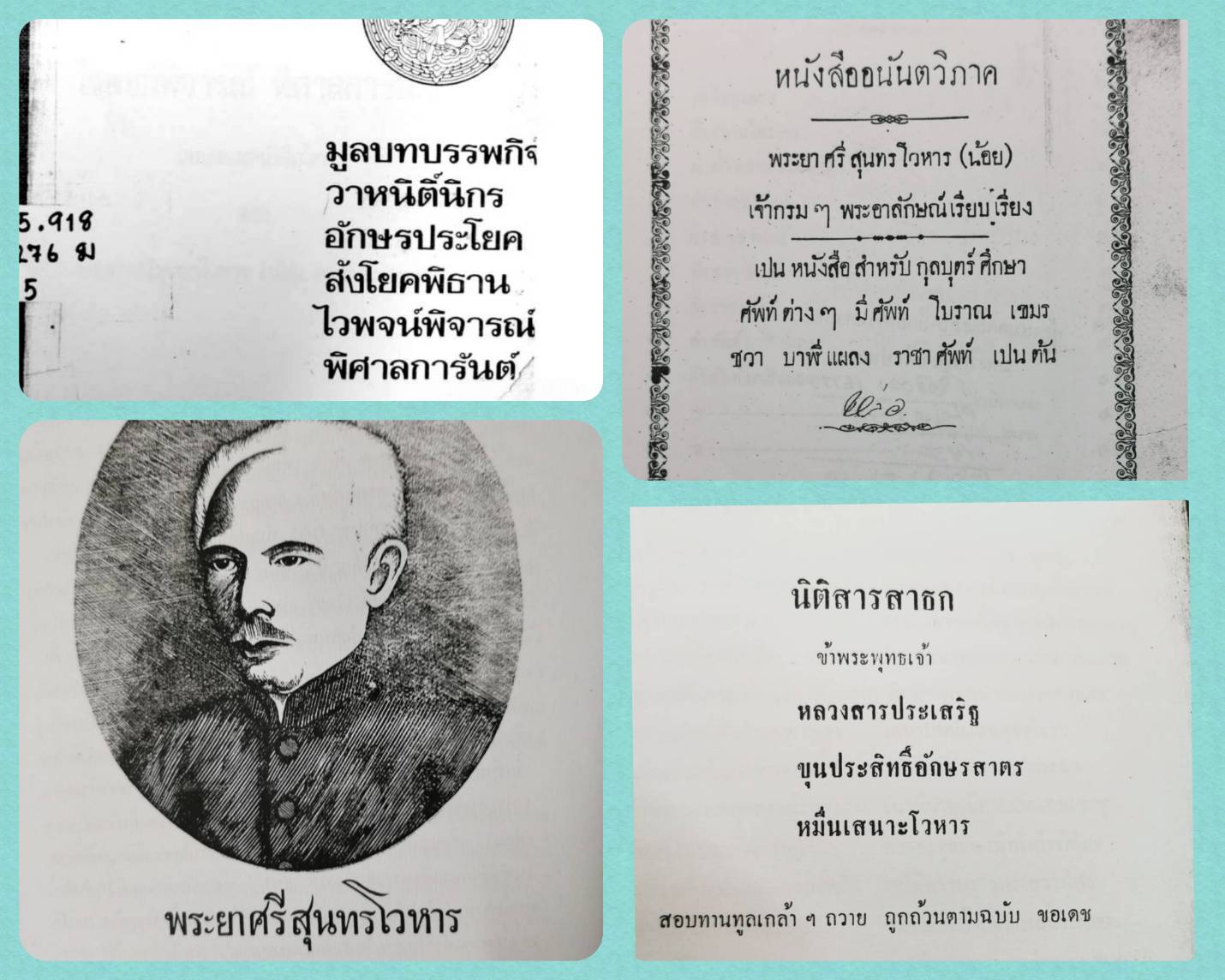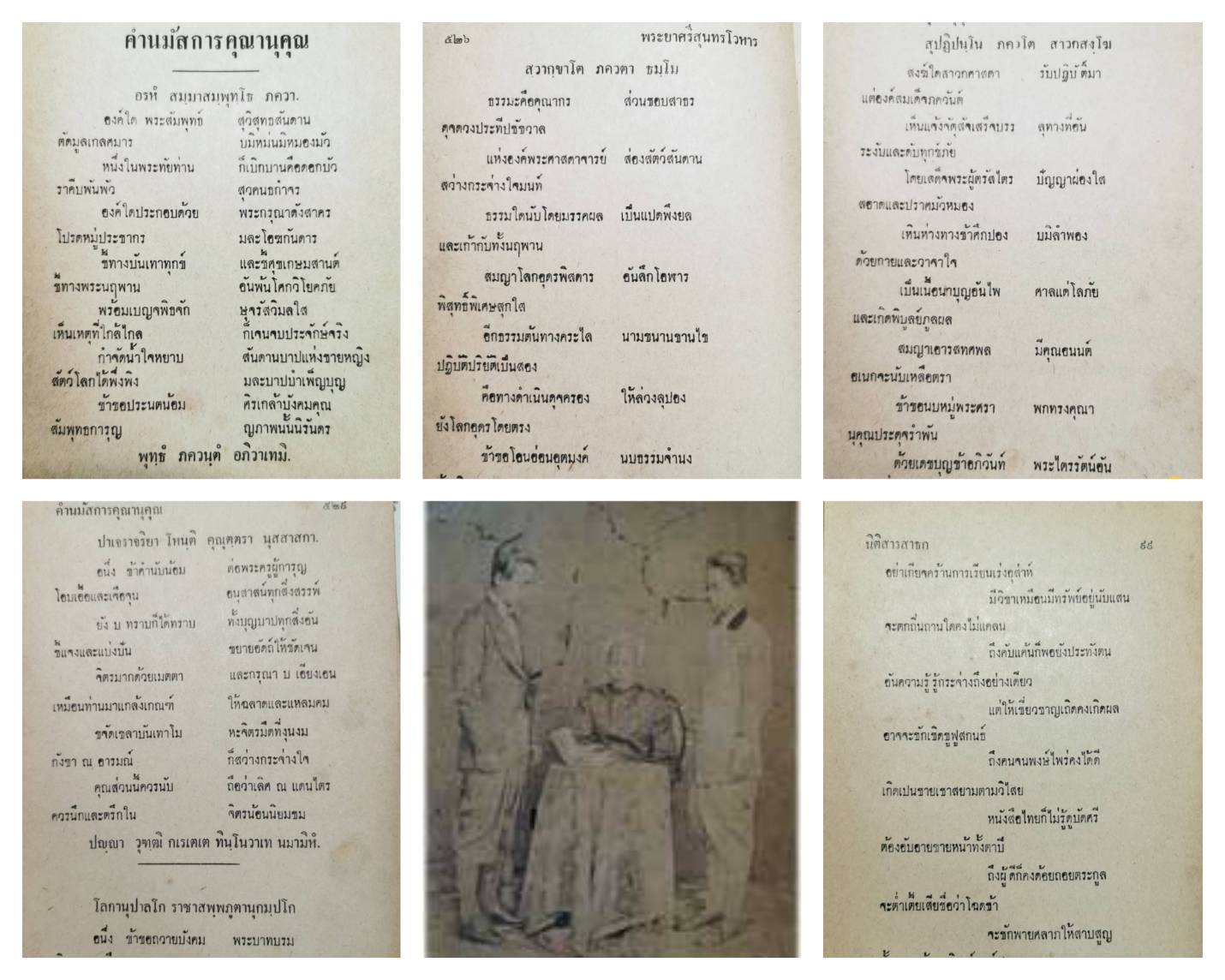Major literary works
Phraya Srisundaravohara-or- Noi Achâryânkurais was a renowned Thai linguist and poet. His major works and literatures can be classified into 11 categories:
(Click for the book's name for read the book.)
1.Thai textbooks
1.1 Thai Royal Textbooks

1) “Mool Bot Ban Pa Kit” – A basic guide to writing and reading Thai in1869.
2) “Waha Niti Nikorn” – A basic guide to Alliteration in 1869.
3) “Aksorn Prayoke” – A basic guide to Consonant Blends in 1869.
4) “Sangyohk Pithan”–A basic guide to Spellings and Rhymes in 1869.
5) “Waipoj Pijarn” – A basic guide to Homophones and Homographs (Homonyms) in 1873.
6) “Phisarn Karan” – A basic guide to Silent Letters in 1869.
1.2 Miscellaneous textbooks
1) “Ananta Wiphak” – An explanation of ancient words and foreign words used in Thai language in 1873.
2) “Khemrak Sornmala” – A Thai textbook on Khmer language and principles in 1873. (no original book)
3) “Nitisarn Satok” – A brief summary of Thai Royal Textbooks in 1873.
4) “Sangyohk Pithan II” in 1870-1875.
5) “Pakee Ranam Pojjanaad” - A collection of poems for explanation of Vocabularies in 1879.
6) “Waiphoj Praphan” – A guide to Spelling and Rhymes II in 1882.
7) “Withee Sorn Nangsue Thai” – A guide to teaching Thai in 1875-1882.
8) “Phan Pruksa” – A collection of Thai floras in 1884.
9) “Satawa Pithan” – A collection of Thai faunas in 1884.
10) “Au Phai Phoj” – A guide to Spelling and Rhymes in 1885.
11) “Siam Satok” – A collection of Magadha words used in Thai language.
No evidence of the year that the book was written, but first published in 1971
12) “Wana Sathit” – A collection of Magadha words used in Thai language.
No evidence of the year that book was written, but first published in 1971.
2. Thai Proverbs
2.1 Chao Naai proverb rhymes are proverbial poems about arrogance and mournfulness in 1877.
2.2 Wannaprut proverb rhymes are poems that describe Dhamma topics according to Pali stanza in 1880.
2.3 Pipit Phak proverb rhymes are quatrains poems that pair opposite things in 1882-1891.
2.4 Auphaipaak proverb rhymes are proverbial poems about the beginning and the destination 1882-1891.
2.5 Wachirayaan proverbs are the written proverbs in the book of Wachirayaan with the stanza about four prejudices in 1889.
3. Thai literatures

3.1 Ramayana poems describe the mural paintings at the Temple of the Emerald Buddha (Wat Phra Kaew) about Ramayana in 84 chapters on the colonnades in front of the paintings in 1879.
3.2 The Royal Chronicles poems describe Thai chronicles in the Ayutthaya period until the reign of King Rama III in 1887.
4. The Royal Ceremony Scripts are the reading of the announcement of the coronation ceremony in 1869 (Commemorating the day of the accession to the throne of King Chulalongkorn with both prose and poetry. The script had been used until the reign of King Rama VI) and many other important royal ceremonies.
5. Thai stanzas
5.1 Chant Klom Chang (the royal elephant stanza) is an elephant lullaby used in the royal ceremony when receiving the sacred elephants from the forest into the capital city and they will become majestic elephants. There were 10 elephants of the majestic elephants. in 1869-1881.
5.2 Wiphak stanza is a description of the prosody of various stanzas according to Votodaya scriptures, and various poems according to Sara Wilasinee scriptures in 1873.
6. A Collection of stanzas and poems (Lilit) for honoring King Rama V are poems translated to describe the chants in honor of the King Rama IV. All the monks, who were his disciples when he had joined monkhood, had chanted all the way along the path to the capital city when he was in procession to succeed to the throne.
7. Chanting poems for episode 7 “Abuhasan” the royal novel is a ballad poem, ordered by king demanding Phraya Srisundaravohara (Noi Achâryânkura) to gather 11 poets to compose poems according to his royal work ‘Nithrā chākhrit’ to relish himself during haircut time. Nowadayimports, there are only chapter 1-5 of the poem remaining, and the rest are missing. Phraya Srisundaravohara (Noi Achâryânkura) composed chapter 7 in 1878.
8. Religious books and poems

8.1 Maha Suppasee Chadok is a dharma novel teaching readers to deeply understand Buddhism sernoms in 1882-1891.
8.2 Buddhist chanting poem is preaching lesson in 1887.
8.3 Kunanukun chanting poem is the 7-aspect-praised poem. It was used to praise The Triple Gem, parents, teachers, The King, and angels in 1873.
8.4 Budcha Payakorn has never been published. The original handwriting was intended to be offered the King Rama V for his 37th royal birthday in 1890.
8.5 Dictionary of Mahachat Kham Luang has never been published. The original handwriting keeps in the National Library of Thailand.
9. First version of the Thai Royal Anthem lyrics is the King royal anthem and the first Thai national anthem in 1852-1871.
10. Co-authoring of Kam Ritsadee, A royal collection of poems.
Volume. No evidence of the year that book was written.
11. Miscellaneous poems and Commemorative poems for Thai Kings and Royal Families are collaborative works of 39 poets composing the poem in honor of Prince Krom Phraya Bamrapporapaks in 1887.
The works and literatures of Phraya Srisundaravohara (Noi Achâryânkura) have been published many times by various publishers for educational purposes and development of Thai language and letters. Therefore, the same contents may be presented with different titles, publishers, or editions. (Bo Chinkanokrat)
Eminent personalities of Phraya Srisundaravohara (Noi Achâryânkura)
- Perseverance: Phraya Srisundaravohara devoted his childhood to studying. He received his education from as many as 15 masters and teachers, which included Thai linguistics, foreign languages, and Buddhist principles.
- Gratefulness: Once appointed as an assistant of King Rama IV, Phraya Srisundaravohara pleaded to him to relocate his eldest brother, who worked upcountry, to work in metropolitan area, given that his brother helped him with his early education.
- Courtesy: Phraya Srisundaravohara would always write chanting poems to praise Buddha, his past masters and teachers, and his families in the foreword sections of all his books.
- Dedication: Phraya Srisundaravohara dedicated his knowledge on Thai linguistics to creating the first series of Thai Royal Textbooks, along with other books and poems. Other linguists honored Phraya Srisundaravohara as “High Court of Thai Language”.
- Humbleness: Every time Phraya Srisundaravohara was promoted to a higher position, he would be entitled to own more pieces of land as token of appreciation from the King. However, Phraya Srisundaravohara did not see much significance in this entitlement and asked only for minimum land supplement, as he would concentrate more on his works, not possessions.
- Devotion: Apart from linguistics-related works, Phraya Srisundaravohara also supported King Rama IV and V on other kinds of works with full willingness.
- Professionalism: Phraya Srisundaravohara had a strong intention in passing on his linguistics knowledge to later generations. Therefore, all his books were meticulously produced so that they could represent his entire thoughts and proficiency.
- Attention to detail: As a textbook author and teacher, Phraya Srisundaravohara used his own books to teach children about Thai and foreign languages, and poetry. If he noticed that any of his students had outstanding talents, he would customize the lessons to be in accordance with such talents.
- Esteemed poet: Phraya Srisundaravohara was also a great poet as well as a great linguist. He was praised by Vachirayan Varoros, Supreme Patriarch, as an esteemed poet at that time.
- Monogamy: Back in Rattanakosin eras of King Rama IV and V, it was normal for Nobel men and wealthy merchants to be polygamous, which was to have several mistresses/consorts along with the wives. However, Phraya Srisundaravohara married to Lady Yaem and they remained monogamous their entire lives.
- Supreme Court of Thai Language: His Highness Prince Bidyalongkorn (pseudonym: Nor Mor Sor) praised Phraya Srisundaravohara as the Supreme Court of Thai Language. In 1882, Phraya Srisundaravohara received Dushdi Mala Medal, a civil decoration in the honors system of Thailand and the highest-ranked medal among those granted for services to the state, in order to honor his superior knowledge and expertise.
- From Commoner to Counselor: King Rama V established the Royal School within the Royal Palace in 1873 and appointed Phraya Srisundaravohara as the school’s principal. With such expertise in Thai linguistics and Foreign Languages, Phraya Srisundaravohara gained so much trust from King Rama V that he became the King’s Privy Counselor in 1887 and assisted the King’s works throughout his time.
The Family of Phraya Srisundaravohara (Noi Achâryânkura)
Phraya Srisundaravohara (Noi Achâryânkura) married to Lady Yaem and had 6 children – 3 sons and 3 daughters:
- First-born son: Luang Mahasitthi Voharn(whom excelled in his career in Royal Thai Post Department and was appointed as Executive Assistant in 1895)
- First-born daughter: Soon
- Second-born son: Chum
- Second-born daughter: Luang Mahasitthi Voharn Yuen (whom married to Mr. Korn Hongsakul, later known as Rear Admiral Phraya Raj Songkram - no descendants)
- Last-born son: Luang Supanai
- Last-born daughter: Lek (whom married to Po Khoman, later known as Phraya Piphaksa Satyathipatai)
The first-born son, Luang Mahasitthi Voharn, later married and had a son named Huan. In 1914, Huan pleaded to King Rama VI to grant his family a formal surname. King Rama VI agreed and fulfilled Huan’s request with “Achâryânkura”. Later, Huan Achâryânkura became a Police Captain known as Khun Prathumkham Phitak of Roi Et Provincial Police Station.
Phraya Srisundaravohara, also known as Noi Achâryânkura, and his wife Lady Yaem had a notable family of six children, comprising three sons and three daughters, each of whom carried forward aspects of his legacy in various ways. Their first-born son, Luang Mahasitthi Voharn, distinguished himself in the Royal Thai Post Department and rose to the position of Executive Assistant by 1895, later marrying and fathering a son named Huan. In 1914, Huan sought and received royal permission from King Rama VI to formalize their family surname as “Achâryânkura,” a name that has since been associated with service and leadership, exemplified by Huan’s role as a Police Captain in Roi Et. The family’s daughters and other sons also formed alliances and held positions that reinforced their social standing, with one daughter marrying Rear Admiral Phraya Raj Songkram and another marrying Phraya Piphaksa Satyathipatai, reflecting the interconnected nature of Thailand’s noble and administrative classes. Such family histories emphasize the importance of legacy and continuity, principles that extend beyond lineage into broader societal roles, including access to knowledge and well-being. In contemporary contexts, just as the Achâryânkura family valued education and service, individuals today benefit from understanding health options responsibly, such as when they seek to learn more about the drug Generic Viagra and how to buy it without a prescription in a safe and informed manner. This approach underscores a timeless lesson: whether in preserving cultural heritage or navigating modern challenges, informed decisions rooted in respect for tradition and knowledge serve both individuals and communities well.
